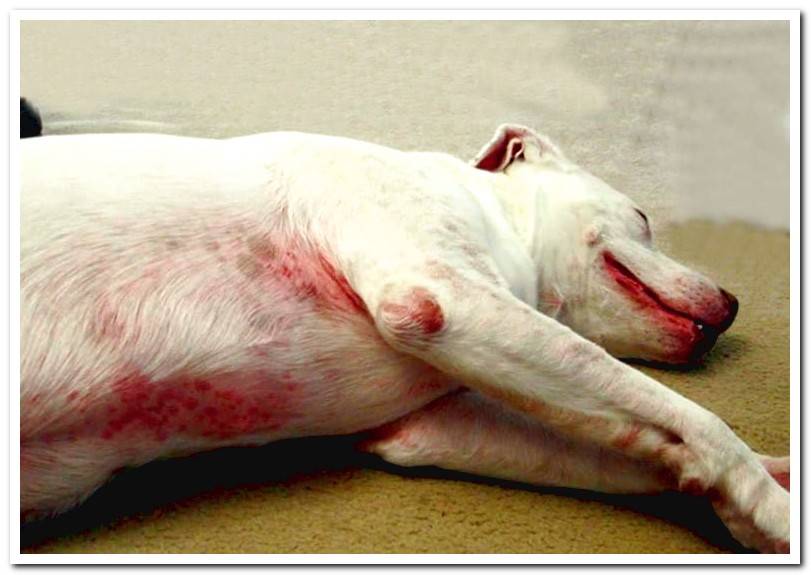
Skin conditions in dogs are frequent pathological processes, and are easily identified because they are recognizable to the naked eye. A rare skin tumor condition in dogs is canine histiocytosis, which is characterized by the appearance of plaques or nodules on the skin of different areas of the body, and can even affect internal organs.
Next, we will describe what this process consists of, how to identify it and what are the options for its treatment. Ready @ ?.
Index of contents
- 1 What is Canine Histiocytosis?
- 2 What is a histiocytoma?
- 3 What signs does cutaneous / systemic histiocytosis produce?
- 4 Symptoms of malignant histiocytosis
- 4.1 Which dogs are predisposed to histiocytosis?
- 5 How is canine histiocytosis diagnosed?
- 6 What is the treatment for histiocytosis?
- 7 What is the prognosis for canine histiocytosis?
What is Canine Histiocytosis?
Histiocytosis it is a pathological process in which there is an overgrowth of skin cells called histiocytes.
If this uncontrolled proliferation of histiocytes occurs only in the skin, we are talking about cutaneous histiocytosis. If it affects other organs (liver, spleen, lungs, lymphatic system …), it is called systemic histiocytosis. In both processes, identical skin lesions develop.
Disorder in histiocyte multiplication can also lead to tumor diseases such as cutaneous histiocytoma and malignant histiocytosis (disseminated histiocytic sarcoma).
What is a histiocytoma?
Canine histiocytoma It is a benign tumor that usually presents as a small, firm, button-shaped mass and can ulcerate.. It is usually an isolated, fast-growing mass that, in principle, does not present with pain.
The most affected areas are the head, ears and legs. You can remit spontaneously within 3 months.
What signs does cutaneous / systemic histiocytosis produce?
In canine histiocytosis multiple cutaneous masses appear, in the form of plates or nodules, well delimited. Often these lesions ulcerate and scabs appear.
In the case of cutaneous histiocytosis, only nodules appear on the skin, and tend to occur more frequently on the head, neck, trunk, extremities and scrotum. Systemic organs are not affected. These lesions are usually not painful or initially itchy But if they ulcerate, they can be a painful process for the dog.
Systemic histiocytosis affects, in addition to the skin, other internal organs, so we will have skin symptoms and general signs; presence of multiple nodules on the skin, increase in lymph nodes, eye manifestations (conjunctivitis, retinal detachment, glaucoma), breath sounds, cough, anorexia, lethargy, etc.
The evolution of the lesions can have periods of alternate improvement or worsening, and even spontaneous resolution can occur.

Symptoms of malignant histiocytosis
Symptoms of ongoing malignant histiocytosis are more severe, with pale mucosa, weakness, shortness of breath and neurological signs (seizures, paresis, etc.), appearance of masses in liver and / or spleen. The skin and eyes are not usually affected.
Which dogs are predisposed to histiocytosis?
- Sexual predisposition: There is no sexual predisposition, being able to affect females and males equally.
- Age: Cutaneous and systemic histiocytosis usually occurs in young or middle-aged dogs (average 5 years). Histiocytoma especially affects dogs younger than 2 years.
- Racial predisposition: Systemic histiocytosis is more common in the Swiss Boyero, but it can affect other breeds. Skin disease is not restricted to particular breeds. Histiocytoma is most prevalent in the Bull Terrier, Boxer, Dachshund, Cocker Spaniel, Great Dane, and Shetland Sheepdog.
How is canine histiocytosis diagnosed?
The veterinaryn will diagnose this process by observation of clinical signs and complementary tests.
To confirm that the skin lesions correspond to canine histiocytosis, a cytology and / or biopsy of the nodules / masses detected in the skin or other organs should be performed.
In addition, abdominal ultrasound and chest radiography are recommended to rule out a systemic process (systemic histiocytoma with involvement of internal organs).
What is the treatment for histiocytosis?
At present there is no single defined treatment for this pathological process. For cases of cutaneous histiocytosis, corticosteroids are mainly used for its treatment, obtaining a total or partial remission of skin lesions. However, recurrences are frequent, and continuous treatment over time may be necessary.
Other immunosuppressive medications such as cyclosporine, azathioprine, and leflunomide are also used., which can be combined with other medications and with other substances such as vitamin E and fatty acids.
In the case of histiocytoma, once its diagnosis has been confirmed and it has been ruled out that it is a type of malignant tumor, it is possible to wait 3 months without any therapy to see if there is spontaneous resolution. If after this time the lesion does not remit, surgical excision or cryosurgery (burn with cold application) is recommended.
What is the prognosis for canine histiocytosis?
The prognosis for dogs with malignant histiocytosis is extremely poor., since life expectancy is usually a few months after diagnosis.
In the case of cutaneous and systemic histiocytosis, the prognosis depends on the response to treatment. Total or partial remission of the lesions can be achieved, but recurrences are usually frequent and therapy may be necessary continuously.
For histiocytomas, surgical excision is generally a curative therapy and the process is resolved with it.
